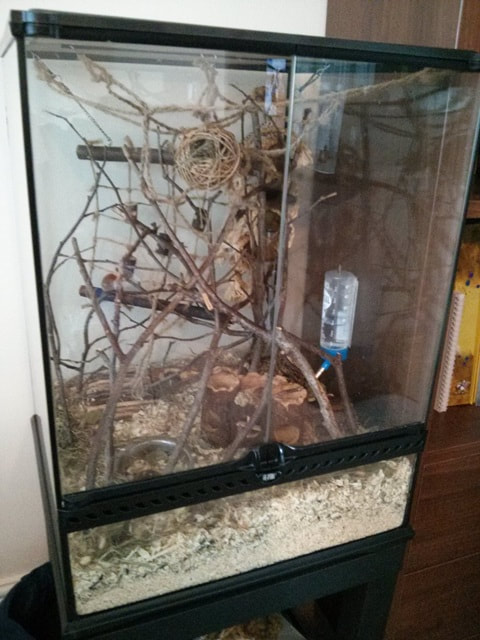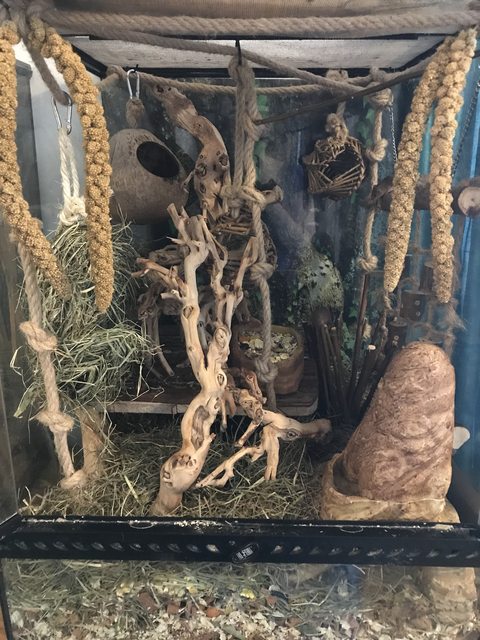General Information:
Harvest mice are a Eurasian species that can be found arable or grasslands. They can weigh as little as a 2p piece.
Fun fact:
Harvest mice are the only mammals in Britain to have a prehensile tail; they're able to grasp or hold objects with their tails. Harvest mice are also considered some of the smallest rodents in Europe. They're a nocturnal omnivorous rodent whose average lifespan is approximately 18 months in the wild, but they can live up to 4 years in captivity.
Care:
Housing/Enrichment:
Due to their small size, it's generally advised to keep harvest mice in a tank to prevent them from escaping. We advise keeping them in a 3ft by 1ft tank minimum - although they're small, they're very active.
Harvest mice love to climb, and they're great at it too. Ensuring they have plenty to climb is prudent. It's advised to avoid plastic toys, but they enjoy plenty of wooden options such as bendy bridges, tunnels, hides, and houses.
Provide them with a generous layer of safe substrate (no less than an inch). We also like to provide our harvest mice with grasses and hay as nesting material, they're very apt at building fantastic little nests.
Useful Links:
Harvest mice are a Eurasian species that can be found arable or grasslands. They can weigh as little as a 2p piece.
Fun fact:
Harvest mice are the only mammals in Britain to have a prehensile tail; they're able to grasp or hold objects with their tails. Harvest mice are also considered some of the smallest rodents in Europe. They're a nocturnal omnivorous rodent whose average lifespan is approximately 18 months in the wild, but they can live up to 4 years in captivity.
Care:
Housing/Enrichment:
Due to their small size, it's generally advised to keep harvest mice in a tank to prevent them from escaping. We advise keeping them in a 3ft by 1ft tank minimum - although they're small, they're very active.
Harvest mice love to climb, and they're great at it too. Ensuring they have plenty to climb is prudent. It's advised to avoid plastic toys, but they enjoy plenty of wooden options such as bendy bridges, tunnels, hides, and houses.
Provide them with a generous layer of safe substrate (no less than an inch). We also like to provide our harvest mice with grasses and hay as nesting material, they're very apt at building fantastic little nests.
Useful Links:
- www.reptilecentre.com/exo-terra-glass-paludarium-large-xtall---90x45x90cm_p23410846.htm
- www.petsathome.com/shop/en/pets/pets-at-home-meadow-feeding-hay-with-timothy-3kg?weight=3kg?utm_source=google&utm_medium=cpc&utm_campaign=google_shopping&cm_mmc=Google-_-CPC-_-%20google_shopping-_-google_shopping&ita=1976&ito=google_shopping&istCompanyId=7255ccad-a1fc-4729-af31-478f79e5071c&istFeedId=385e6b9a-8b03-4076-a8bb-e4737df8549c&istItemId=itxmxqqqw&istBid=tzwt&gclid=CjwKCAjw_o-HBhAsEiwANqYhp7rhQvUE6OoIKs2Vs9NspAdgKkFo86qtt2IRf4Yfjpsmj3HBfTcx3xoCiXYQAvD_BwE&gclsrc=aw.ds
- www.burnhills.com/equestrian-c3/for-the-stable-c12/stable-supplies-c212/bedding-c213/ecoshiv-hemp-shiv-hemp-horse-bedding-aprox-20kg-p4737/s17407?cid=GBP&gclid=CjwKCAjw_o-HBhAsEiwANqYhp1naUmgcjUtUZXlHV7QeWrW9XPlP_ryaGU1hgDdrEy_iss9XCmzJVxoCr94QAvD_BwE
Socialising:
Harvest mice are social animals and would live in small but overlapping territories in the wild. A small number of males can live together.
As harvest mice are prey animals and are not often kept as a domesticated species, they're often difficult to handle and will usually be considered a look-but-don't-touch type of pet.
Please, do not deliberately capture wild mice to be kept as pets. If you do find a wild Eurasian harvest mouse, if it can be released, then do so. If not, then contact a wildlife rehabilitator.
Diet:
As an omnivorous species, harvest mice require both plant and meat-based items in their diet to live a healthy life.
As previously mentioned, they're not commonly kept pets so there isn't a specific commercial diet prepared for harvest mice. Most experienced owners recommend making your own food mix.
A good quality mix of wild bird food, fresh and dried flowers, dried insects, and occasional fruits and vegetables will be sufficient. The majority of their diet should be seeds and grains. Though they will naturally consume insects, they're far less omnivorous than that of house mice and rats.
Common Diseases:
There is little documents about common diseases that occur in Eurasian harvest mice kept as pets. However, we can list some of the common issues we've personally seen when keeping pet harvest mice:
Please feel free to ask more questions
Harvest mice are social animals and would live in small but overlapping territories in the wild. A small number of males can live together.
As harvest mice are prey animals and are not often kept as a domesticated species, they're often difficult to handle and will usually be considered a look-but-don't-touch type of pet.
Please, do not deliberately capture wild mice to be kept as pets. If you do find a wild Eurasian harvest mouse, if it can be released, then do so. If not, then contact a wildlife rehabilitator.
Diet:
As an omnivorous species, harvest mice require both plant and meat-based items in their diet to live a healthy life.
As previously mentioned, they're not commonly kept pets so there isn't a specific commercial diet prepared for harvest mice. Most experienced owners recommend making your own food mix.
A good quality mix of wild bird food, fresh and dried flowers, dried insects, and occasional fruits and vegetables will be sufficient. The majority of their diet should be seeds and grains. Though they will naturally consume insects, they're far less omnivorous than that of house mice and rats.
Common Diseases:
There is little documents about common diseases that occur in Eurasian harvest mice kept as pets. However, we can list some of the common issues we've personally seen when keeping pet harvest mice:
- Tail Injuries: Eurasian harvest mice are the only rodent in British mammal to have a prehensile tail. We've seen numerous tail injuries ranging from a total absence of a tail, or part of the tail being missing, usually due to previous injuries. In captivity, this doesn't seem to impact harvest mice much as we are able to amend their cage to ensure they can fully navigate around. It's important that owners establish if these injuries occurred from another cage mate, and to separate individuals when appropriate.
- Cataracts: Geriatric harvest mice sometimes develop cataracts, which in some cases can totally blind an individual if bilateral cataracts are seen. Harvest mice are particularly resilient and the individuals we've had with cataracts can live full and enriched lives even when blind.
Please feel free to ask more questions


